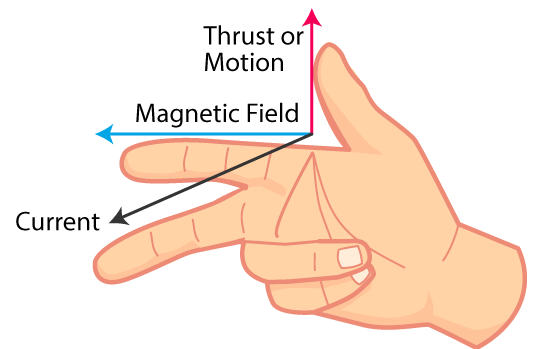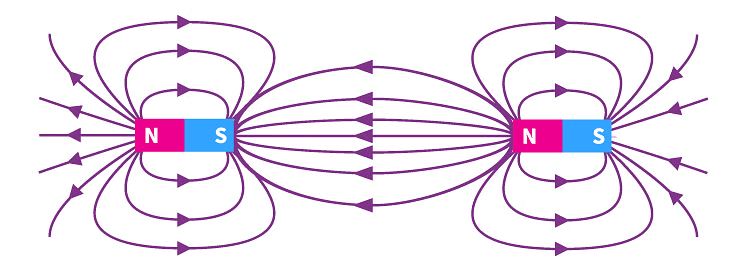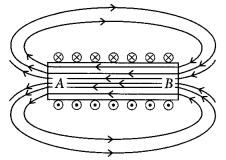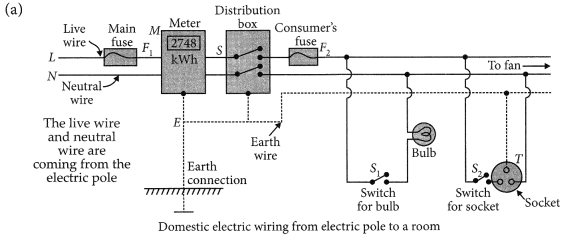Unit Test (Solutions): Magnetic Effects of Electric Current | Science Class 10 PDF Download
Time: 1 hour
M.M. 30
Attempt all questions.
- Question numbers 1 to 5 carry 1 mark each.
- Question numbers 6 to 8 carry 2 marks each.
- Question numbers 9 to 11 carry 3 marks each.
- Question number 12 & 13 carry 5 marks each.
Q1: What is meant by magnetic field? (1 Mark)
Ans: Magnetic field- It is defined as the space surrounding the magnet in which magnetic force can be experienced.
Q2: The strength of magnetic field inside a long current carrying straight solenoid is (1 Mark)
(a) minimum in the middle
(b) found to increase from one end to the other
(c) same at all points
(d) more at the ends than at the centre
Ans: (c)
The magnetic field inside a long solenoid is uniform, meaning it has the same strength at all points along its length.
Q3: The phenomenon of electromagnetic induction is (1 Mark)
(a) the process of generating a magnetic field due to current passing through a coil.
(b) the process of charging a body.
(c) producing induced current in a coil due to relative motion between a magnet and the coil.
(d) the process of rotating a coil of an electric motor.
Ans: (c)
Emitting current into a coil as a result of the coil and magnet’s relative motion is a phenomenon known as electromagnetic induction.
Q4: Choose the wrong statement from the following regarding magnetic lines of the field (1 Mark)
(a) Magnetic field lines are closed curves.
(b) The north pole of a magnetic compass is used to determine the direction of the magnetic field at a particular location.
(c) If magnetic field lines are parallel and equidistant, they represent zero-field strength.
(d) The degree of closeness of the field lines indicates the relative strength of the magnetic field.
Ans: (c)
(c) is wrong because parallel lines of magnetic field represent a uniform magnetic field.
Q5: A circular loop, when placed in a plane perpendicular to the plane of the paper, may carry a current when the key is ON. The current, as seen from points A and B (in the plane of the paper and on the axis of the coil), is anticlockwise and clockwise, respectively. The magnetic field lines point from B to A. The North pole of the resultant magnet is on the face close to (1 Mark)
(a) A
(b) B
(c) B when the current is small and A if the current is large
(d) A if the current is small, and B if the current is large.
Ans: (a)

Based on the right-hand thumb rule: From the right-hand thumb rule, it can be shown that magnetic lines of force emerge from the face close to A, and go into the face close to B. The magnetic fields emerge from the north pole of the magnet and go into the south pole.
Q6: (a) If field lines of a magnetic field are crossed at a point, what does it indicate?
(b) Mention two parameters that are necessary to describe a magnetic field completely. (2 Marks)
Ans:
(a) It is impossible for there to be two magnetic field directions at one location if field lines of a magnetic field intersect at that location.
(b) Necessary parameters are: 1. The magnitude of a magnetic field. 2. The direction of field lines.
Q7: A straight conductor that is carrying current is put close to a compass needle. Give your opinion in each of the following situations, along with your justifications. (2 Marks)
(a) The magnitude of electric current is increased.
(b) The compass needle is displaced away from the conductor.
Ans:
(a) The deflection of the compass needle rises as the magnetic field intensity, which is exactly proportional to the current, increases.
(b) Because the strength of the magnetic field at a location is inversely related to the separation from the wire. As a result, the compass’s deflection diminishes as it is moved away from the conductor.
Q8: List the properties of magnetic field lines. (2 Marks)
Ans: The properties of magnetic field lines are as follows:
- There are no points of intersection between magnetic field lines.
- They start at the North Pole and end at the South Pole.
- The field lines inside the magnet run from the south pole to the north pole.
Q9: Diagram shows the lengthwise section of a current carrying solenoid. ⦻ indicates current entering into the page, ⨀ indicates current emerging out of the page. Decide which end of the solenoid A or B, will behave as north pole. Give reason for your answer. Also draw field lines inside the solenoid. (3 Marks)
Ans: Using right hand thumb rube we can draw the magnetic field lines around the conductor as shown. From figure, end A of solenoid act as north pole and end B will act as south pole. Inside the solenoid field lines are in the form of parallel straight lines.
Using right hand thumb rube we can draw the magnetic field lines around the conductor as shown. From figure, end A of solenoid act as north pole and end B will act as south pole. Inside the solenoid field lines are in the form of parallel straight lines.
Q10: Give a reason for the following. (3 Marks)
(i) There is either a convergence or a divergence of magnetic field lines near the ends of a current carrying a straight solenoid.
(ii) The current-carrying solenoid, when suspended, freely rests along a particular direction.
Ans:
(i) Because a current-carrying straight solenoid operates like a bar magnet and has a bar magnet-like magnetic field line pattern, there is either a convergence or a divergence of magnetic field lines near the ends of the device. As a result, the ends of the straight solenoid behave like the north and south poles of a magnet, with the converging end becoming the north pole. (ii) When suspended freely, the current-carrying solenoid acts like a bar magnet and aligns itself in a north-south direction.
(ii) When suspended freely, the current-carrying solenoid acts like a bar magnet and aligns itself in a north-south direction.
Q11: Two circular coils P and Q are kept close to each other, of which coil P carries a current. What will you observe in the galvanometer connected across the coil Q
(a) if current in the coil P is changed?
(b) if both the coils are moved in the same direction with the same speed?
Give reason to justify your answer in each. (3 Marks)
Ans:
(a) When the amount of current in the coil P is changed, an induced current will induce in the coil Q due to change in magnetic field lines i.e., magnetic flux.
(b) If both the coils are moved in the same direction with the same speed, then there is no net change in magnetic flux. Hence there will be no deflection in the galvanometer.
Q12:
(a) Draw a schematic diagram of a common domestic circuit showing provision of
(i) Earth wire
(ii) Main fuse
(iii) Electricity meter and
(iv) Distribution box.
(b) Distinguish between short circuiting and overloading. (5 Marks)
Ans:
(a) 
(b) Overloading: The condition in which a high current flows through the circuit and at the same time too many appliances are switched on then the total current drawn through the circuit may exceed its rated value.
Short circuiting: The condition when the live wire comes in direct contact with the neutral wire, due to which a high current flows in the circuit.
Q13: A current carrying conductor is placed in a magnetic field. Now answer the following. (5 Marks)
(i) List the factors on which the magnitude of force experienced by conductor depends.
(ii) When is the magnitude of this force maximum?
(iii) State the rule which helps, in finding the direction of motion of conductor.
(iv) If initially this force was acting from right to left, how will the direction of force change if:
(a) direction of magnetic field is reversed ?
(b) direction of current is reversed?
Ans:
(i) When a current carrying wire is placed in a magnetic field, it experiences a magnetic force that depends on
- (a) current flowing in the conductor
- (b) strength of magnetic field
- (c) length of the conductor
- (d) angle between the element of length and the magnetic field.
(ii) Force experienced by a current carrying conductor placed in a magnetic field is largest when the direction of current is perpendicular to the direction of magnetic field.
(iii) The rule used in finding the direction of motion of the conductor placed in a magnetic field is Flemings left hand rule.
Fleming’s left-hand rule is as follows:
Stretch out the thumb, the forefinger, and the second (middle) finger of the left hand so that these are at right angles to each other. If the forefinger gives the direction of the magnetic field (N to S), the second (middle) finger the direction of current then the thumb gives the direction of the force acting on the conductor.
(iv) (a) Direction of force will be reversed when direction of magnetic field is reversed, i.e., now force on conductor will act from left to right
(b) Direction of force will be reversed, if the direction of current is reversed, i.e., the force on the conductor will act from left to right.
|
80 videos|569 docs|80 tests
|
FAQs on Unit Test (Solutions): Magnetic Effects of Electric Current - Science Class 10
| 1. What are the applications of magnetic effects of electric current in hobbies? |  |
| 2. How can I use the principles of magnetic effects of electric current to build a simple motor for my hobby projects? |  |
| 3. What materials are commonly used to build electromagnets for hobby purposes? |  |
| 4. How can I incorporate the magnetic effects of electric current into my hobby of model train building? |  |
| 5. Can I use the principles of magnetic effects of electric current to enhance the sound quality of my DIY speakers for my hobby projects? |  |
















